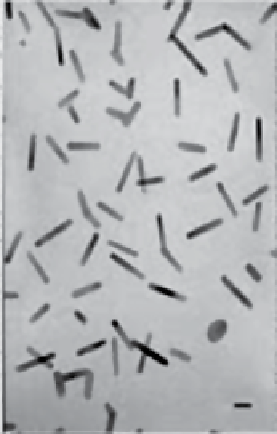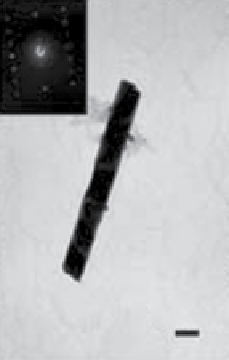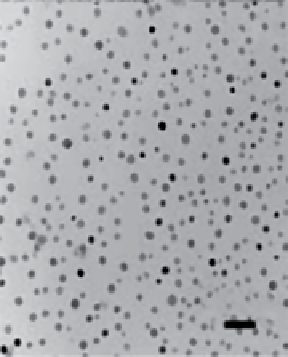Environmental Engineering Reference
In-Depth Information
(a)
(b)
(c)
20 nm
20 nm
100 nm
(d)
(e)
(f)
0.32 nm (200)
100 nm
50 nm
10 nm
fiGure 18.8
(a) TeM image of PbTe nanorods prepared by sonoelectrochemistry at room temperature for 30 min. (b) enlarged TeM image
of PbTe nanorods prepared under identical conditions. (c) TeM image of a nanorod obtained after 45 min of reaction. (d) TeM image of a
nanorod obtained after 1.5 h of reaction; the inserted selected area electron diffraction pattern indicates the single-crystal nature of the shown
nanorod. (e) hRTeM image of PbTe, a nanorod indicating the (200) lattice plane spacing. (f) spherical PbTe nanoparticles synthesized under
a low concentration of Pb
2+
ions (2 mm). Reprinted with permission from Ref [63]. © 2005, Wiley-Vch Verlag Gmbh & co. KGaA, Weinheim.
with a face-centered cubic structure from a saturated solution of silver citrate in the presence of PVP [64]. Under the experi-
mental conditions, spherical Ag nanoparticles with an average size of 20-25 nm were prepared. In contrast, amorphous silver
nanoparticles of 20-nm size were prepared from an aqueous solution of AgBr in the presence of gelatine [72].
however, lei et al. prepared spherical nanoparticles of tungsten by pulsed sonoelectrochemistry [73]. The mean diameter of
these nanoparticles was 30 nm, and some aggregated particles were observed.
Qui et al. synthesized highly dispersed palladium nanoparticles by pulsed sonoelectrochemistry methods with diverse sizes and
shapes using an ionic palladium solution in the presence of cetyltrimethylammonium bromide [74]. Mostly, spherical nanoparti-
cles with an average size of 4-5 nm were obtained. however, a longer reaction time than 2.5 h resulted in dendritic-structured Pd.
The dendritic palladium was made up of numerous spherical Pd nanoparticles with a diameter of approximately 10 nm. Zinc [61,
65], nickel [61, 75], and cobalt [61] nanoparticles have also been successfully synthesized by pulsed sonoelectrochemical methods.
Nanoparticles of very reactive metals with a high negative reduction potential, for example, magnesium and aluminum, can
also be synthesized using pulsed sonoelectrochemistry.






